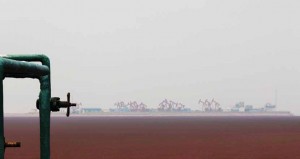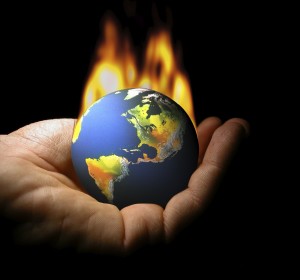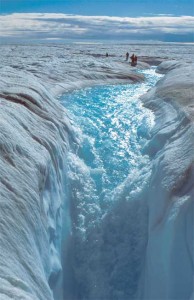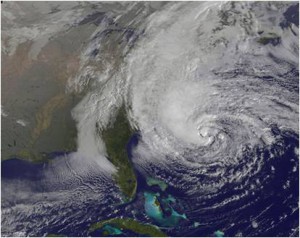The Problem
There seems to be a perverse relationship between the number of negotiations for a global deal on climate change and the level of carbon dioxide (CO2) in the atmosphere. The more people meet to talk about climate change, the more hot air is blown into the atmosphere. Despite the crystal clear scientific evidence of human-caused global climate change, with dangerous consequences, the political process moves on as if the worst consequences of climate change cannot happen. But they will happen.
Fred Ludens
The rest of us, who are not participants in the global negotiations, need to keep plugging along, learning what we can about the latest atrocious news on climate change and trying to figure out how to talk about climate change so that a clear majority of voters form a consensus on climate action. To help that process, we digest five recent reports on climate change that reinforce the grounds for our growing concern. The news is not particularly new but the sources are an interesting mix: an analysis from an accounting firm for its clients, and the general public; a peer-reviewed science journal article; a US National Research Council analysis for the US military and intelligence communities; a report for the World bank by a Potsdam Institute; and a report by the European Environment Agency. They all reaffirm what we already know: we’re in deep trouble.
Certain of these reports were likely timed to coincide with the next round of global climate talks, in Doha, Qatar, and to serve as a warning about what can or will happen if the international community fails, once again, to adopt clear, concrete plans to avoid the worst consequences of our unreasonable reliance on fossil fuels.
PricewaterhouseCoopers’ Low Carbon Economy Index 2012
The report by PricewaterhouseCoopers (PwC), issued annually based on its Low Carbon Economy Index, is entitled Too late for two degrees? The reference is to the international commitment, really an aspiration, to keep us below a 2°C (3.6°F) rise in global temperature compared to pre-industrial levels. The opening line to the report answers the question: “It’s time to plan for a warmer world.” In an understatement, PwC concludes that “Governments’ ambitions to limit warming to 2°C appear highly unrealistic.” At 2.
PwC uses a measure of carbon intensity for various countries as a tool to assess progress towards a low carbon economy. It evaluates the rate of decarbonisation of the global economy that is needed to limit warming to 2°C, or to hold carbon dioxide concentrations in the atmosphere at 450 ppm. The carbon intensity of an economy is the emissions per unit of Gross Domestic Product (GDP) and is a function of a country’s fuel mix, energy efficiency, and extent of carbon-intensive sectors, as outlined in the report.
If we want to keep global temperatures at a 2°C rise, then we need to decarbonize at a rate of 5.1% per year from now to 2050. That level of decarbonisation has not happened in any year since World War II and we would need to decarbonize at that level for each of the next 39 years. Unfortunately, the current average rate of decarbonisation since 2000 is 0.8% per year. Even with a worldwide economic downturn, carbon intensity fell less than 1% each year from 2008 to 2012. While an economic downturn can lower carbon intensity, it also makes it difficult to finance steps toward a low carbon economy. And the economies of the developing countries of China and India are still expected to double by 2020.
While some seize on the explosive growth of shale gas in the US as a possible transition fuel to a low carbon economy, the PwC report points out that there are continuing questions about the actual level of GHG emissions from shale gas, in comparison with coal and other fossil fuels, and that the environmental impacts from shale gas extraction and use are of concern. Moreover, lower gas prices drive coal prices down, which raises demand for coal in developing economies, and shale gas investment may undermine incentives for investment in renewable energies and lock economies into a further dependence on fossil fuels.
 As PwC claims, business leaders have been asking for clarity in political policies and actions on climate change, and not getting it. Businesses are beginning to realize that investments in long-term assets and infrastructure, especially in coastal or low-lying regions, now have to address the reality of a global climate warming at much higher levels. And businesses understand that when the politicians finally wake up, or the public shakes them up, more stringent regulations and controls are inevitable.
As PwC claims, business leaders have been asking for clarity in political policies and actions on climate change, and not getting it. Businesses are beginning to realize that investments in long-term assets and infrastructure, especially in coastal or low-lying regions, now have to address the reality of a global climate warming at much higher levels. And businesses understand that when the politicians finally wake up, or the public shakes them up, more stringent regulations and controls are inevitable.
So the advice is, we had better plan for a warmer world. Even if we doubled the current decarbonisation to 1.6% each year to 2050, we would end up with equivalent CO2 levels of 1,200 ppm with a 6°C (10.8°F) average increase above pre-industrial levels. Never forget that these are temperature increases averaged over the entire globe and that some places will experience much warmer increases. Such a scenario is truly disastrous.
A Peer-reviewed Article on A Less Cloudy Future: The Role of Subtropical Subsidence in Climate Sensitivity
From a study by an accounting firm we turn to a peer-reviewed article in Science, a leading journal, for further evidence of where we stand on controlling greenhouse gas (GHG) emissions. In the article, John Fasullo and Kevin Trenberth, scientists at the US National Center for Atmospheric Research (NCAR), evaluated sixteen leading climate models to determine how well they reproduced actual observed relative humidity. The research was funded by the US National Aeronautics and Space Administration (NASA).
Climate computer models attempt to quantify the interactions of atmosphere, oceans, land surface and ice to estimate the expected increases in global temperatures that result from increases in GHG emissions. A major problem with models has been how to measure the effects of clouds on atmospheric conditions and temperature increases, and this uncertainty accounts, in part, for the wide range of projections for future temperature increases, ranging from 3°F to 8°F.
Fasullo and Trenberth analyzed the ability of the climate models to accurately measure water vapor and the global distribution of relative humidity as a reliable substitute for clouds. They focused on the accuracy of the models to reflect the actual, observed relative humidity in certain dry zones in subtropics. They found that the climate models that most accurately captured the observed dryness were the models that also projected a global temperature rise, assuming a doubling of CO2, to more than 7°F. The authors conclude that the climate models that project higher increases in global temperatures are more reliable than those that project lower temperatures. In other words, global warming is likely to be on the high side of projections. Forget a 2°C (3.6°F) rise and get ready to live with, or die by, a rise of 4°C (7.2°F) or higher, consistent with the PwC study and the World Bank report, discussed below.
Climate and National and International Security
The National Research Council, part of the US National Academy of Sciences, was commissioned by the US intelligence agencies, including the Central Intelligence Agency (CIA), to assess the connections between climate change and political and social stresses that may impact on U.S. national security concerns. The language of the report, Climate and Social Stress: Implications for Security Analysis, especially in the Summary but less so in the body of the report, is at times almost impenetrable (e.g., “climate perturbations”), almost as if the authors were mimicking the coded language of security bureaucrats. But the basic message sifts through.
U.S. Pentagon
Unlike climate skeptics in Congress, this report does not question whether climate change is real or largely influenced by human actions and at the outset the Council makes it clear that “Climate change is occurring, is caused largely by human activities, and poses significant risks for—and in many cases is already affecting—a broad range of human and natural systems.” At 1-5. Just as the intelligence communities assess the ability of foreign governments and societies, especially those in which American interests may be implicated, to withstand various kinds of social and political stress, even upheaval, this report assesses climate risks and the exposure and vulnerabilities of societies affected by those climate risks. The goal is to help the intelligence communities identify and target places at risk from climate stresses and to devise ways to reduce the susceptibilities to those risks and to improve coping, response and recovery operations. While the report focuses on places outside the U.S., the Council acknowledges that with climate change impacts in the U.S., the role of the defense forces in helping areas recover from extreme weather will continue to expand, as we have seen in Hurricane Sandy.
The study suggests that no more than 12 to 15 countries will need to be monitored for potentially disruptive climate events over the next decade, and many of these will be in the watershed areas of South Asia, the Middle East and Africa. The litany of disruptive climate events is familiar: sea-level rise, the shrinking of glaciers and the Arctic icecap, an increase in extreme weather events, and increasingly intense droughts, floods, and heat waves. Within the vulnerable areas, it is expected that some states may fail, that large numbers of people will be forced to migrate across international borders, because of drought, floods, famine or disease, and that national and international aid agencies will lack the resources to help these places cope with the climate changes.
While climate change alone does not cause conflict, it likely will act as “an accelerant of instability or conflict” placing burdens on foreign governments to cope with the consequences. Sea level rise could threaten large parts of Bangladesh and force millions of people to migrate to neighboring India. In sub-Sahara Africa, millions may be forced to migrate to escape extended periods and large areas of drought, and many will seek refuge in European countries. Extreme weather events will cut off global supply lines for food and/or fuel. With melting of Arctic ice, newly accessible sea routes and natural resources are food for international conflicts.
The three previous studies indicate the probabilities of the earth warming to much greater degrees than expected even in the last IPCC report, and the risks of climate warming to security interests. Now we turn our attention to studies that draw out the implications for this riskier, warmer climate.
The World Bank’s 4°C Nightmare Scenario
A World Bank report, Turn Down the Heat: Why a 4°C Warmer World Must Be Avoided, produced by the Potsdam Institute for Climate Impact Research and Climate Analytics, focuses on developing countries and poor communities. The World Bank acknowledges, and supports, the internationally agreed goal to hold global mean warming below a 2°C increase above the preindustrial climate, and accepts that even a 2°C increase may be too dangerous. At the same time, like the PwC and Science article, the Bank accepts that “the sum total of current policies—in place and pledged—will very likely lead to warming far in excess of this level. Indeed, present emission trends put the world plausibly on a path toward 4°C (7.2°F) warming within this century.” At xiii.
The Bank proceeds to draw out the implications if we allow this 4°C to take place. Here are some of the implications from unprecedented heat waves, severe drought and major floods, with many more detailed in the report.
A 4°C rise in temperature by 2100 will result in a 150% increase in the acidity of the ocean, with extensive destruction of marine organisms and ecosystems, including coral reefs that provide a buffer against storm surges and wave damage and provide food for local communities.
For sea level rise, the study points out that the average increase over the 20th century has been about 15 to 20 centimeters, but it is increasing over the century and if left unchanged will result in a sea-level rise of 30 cm (about a foot) by end of the 21st century. If we allow a warming of 4°C, then the sea-level rise will be 0.5 to 1 meter (1.6 to 3.2 feet). But this is an average rise over the globe and there will be regional variations, with a sea-level rise of 20% higher in some places, and even variations within regions and countries.
Regional and other variations also will show up in the rainfall levels, with drier conditions and water scarcity affecting Africa, Middle East and South Asia, and wetter conditions affecting North America, northern Europe and Siberia.
Recent studies indicate that such changes will lead to crop yield reductions and failures, undermining food security on a global basis, a concern identified in the National Research Council study discussed above.
The changes in temperature and rainfall affect the food supply, and in turn the loss of food supply affects health conditions with increases in nutritional deficits and epidemic diseases.
As the 4°C rise impacts water availability, ecosystems, agriculture and health, these effects will in turn lead to large-scale displacements of populations that will disrupt economic and trade systems and threaten the security of affected regions, and countries relying on those countries for food, energy and natural resources.
These assessments likely underestimate the risks because as we get closer to a 4°C rise, or higher, there is an increasing likelihood of crossing the threshold for tipping points in the earth’s systems leading to unprecedented abrupt climate changes. Examples of such abrupt changes are the disintegration of the West Antarctic ice sheet, with sea-level rises greater than anything set forth in this report, or release of methane from thawing permafrost, as recently warned by the United Nations.
As food and energy supplies, and entire economies, become increasingly linked globally, any abrupt change in one part of the world will reverberate far and wide.
No wonder the World Bank concludes with a plea, which is also a threat: “The projected 4°C warming simply must not be allowed to occur—the heat must be turned down. Only early, cooperative, international actions can make that happen.” At xviii.
There are few signs that this plea is being heeded.
The ICJ Project
EEA on climate change, impacts and vulnerability in Europ
Recently the European Environment Agency (EEA) published an assessment of past and projected climate changes, their observed and projected impacts, and the associated vulnerability of and risks to society, human health, and ecosystems in Europe. The report is an update to earlier such assessments in 2004 and 2008. While the EEA report covers many of the risks discussed elsewhere, it also focuses on the differential impacts in particular European regions and communities, and adds a useful discussion of the interplay between climate risks and socio-economic conditions and the resulting vulnerabilities of certain communities. As the EEA states, “Socio economic developments have a significant (and often dominant) role in the exposure and vulnerabilities of regions, sectors or population groups to climatic and other hazards.” At 40. This focus on vulnerable people is also a particular concern for the Mary Robinson Foundation for Climate Justice.
Socio-economic conditions unfolding in Europe that will affect how different communities cope, or fail to cope, with climate change include: fertility rates will rise slightly; further life expectancy gains are projected; inward net migration to the EU continues, but decelerates; EU population is projected to increase up to 2040 and decline thereafter; EU population will undergo significant changes in its age structure, with an aging population; the old-age dependency ratio in the EU will double; labour supply will decline because of the projected population trends; and, markedly lower potential economic growth rates are projected for the EU.
The EEA observes that northern and north-western Europe, including the Republic of Ireland (RoI) and the United Kingdom (UK), will experience higher rainfall with increases in the intensity and frequency of winter and spring flooding of coastal areas and rivers, due to sea-level rise and an increased risk of storm surges. Southern Europe will experience drier conditions with lower rainfall, leading to more frequent and intense droughts. There is also reduced demand for heating in northern areas and greater demand for energy for cooling in southern areas. Snow covering has been decreasing and the vast majority of glaciers in Europe have been receding, consistent with melting of the Greenland ice sheet and the rapid lowering of sea ice in the Arctic.
Melting Greenland ice sheet. Roger J. Braithwaite, The University of Manchester, UK and NASA.
There has also been earlier occurrence of spring seasonal events, a lengthening of breeding seasons, and a northwards and uphill movement for many plant and animal species. Several crops have also expanded northward with possible increased yields in northern Europe, and at the same time there has been reduced yields of crops due to heat waves and droughts with increased water demands. The increases in flooding and heat waves will continue to exert significant tolls on the health of affected areas, and large costs.
To state the obvious, richer European countries will be better positioned to reduce the impacts of climate change and poorer countries will suffer the consequences. The current economic crisis across Europe may foreshadow wider and deeper conflicts within the European Union when climate changes bring about the risks, and damages, covered by the EEA and other reports discussed here. As the EEA points out, there exist significant differences across Europe, as well as between developed and developing countries, in economic, technical, and institutional capacity to cope with climate change. The EEA concludes that “[A]n integrated assessment of European regions’ vulnerability to climate change suggests that climate change may negatively affect the territorial cohesion in Europe by deepening existing socio economic imbalances.” Summary, at 17.
Conclusion
Most reports from the United Nations, and other organizations, continue to take the public position that we can still preserve a 2°C (3.6°F) rise in global temperature by mid-21st century, but only if the international community acts quickly and aggressively. Clearly if we give up on the 2°C goal, or aspiration, and remain with business-as-usual, then there is real concern that GHG emissions will run amok and we will face a rise of 5°C or greater, with catastrophic consequences. Unfortunately, there is little signage of anything quick or aggressive taking place in the climate change political arena.
International negotiations remain listless. The UK coalition government seems to have abandoned any attempts to pretend it is progressive on climate change. The Irish coalition government is largely absent on the issue. Other than the Green Party, there is little leadership on environmental issues in political parties on the island of Ireland, but some hope in Northern Ireland based on the progressive policies of Minister Alex Attwood. America remains hostage to fossil fuel financial interests and regressive Tea Party politics, both represented by the notorious Koch Brothers.
If Hurricane Sandy inflicted such damage on New York City’s infrastructure with a 11-ft storm surge, what do you think NYC will be like with a dramatic sea level rise and accompanying storm surges. Recent studies indicate that we are likely to get a sea level rise of five feet or higher and that would submerge, permanently, about 7% of New York City. In addition, New York City would average a flood as high as Hurricane Sandy’s about every 15 years. With a sea level rise of 25 feet, about 40% of New York City, including most of Manhattan below 34th Street (Macy’s), would be permanently submerged. See New York Times article in the Sources. At the same time, kiss Venice goodbye and expect millions of environmental refugees crossing international borders, unless militarily blocked.
While this sounds like a hopeless cause, it is not.
Clearly political action will come only if there is a clear majority of voters demanding climate action. We all need to keep working on that consensus.
The irony is that environmentalists’ best hope may be in multinational businesses, and their accountants like PwC and insurers, that understand climate change and increasingly are frustrated with politicians’ unsteady, unclear and contradictory signals on energy and climate change policies. Recently more than 100 of the world’s largest companies called for governments to bring in a global carbon price to drive the huge investment needed to deliver substantial reductions in GHG emissions. There is also hope in military and intelligence agencies that also understand the realities of climate change and the need to anticipate and plan for socio-political fallout, and threats to national and international security, from climate changes.
On his last speech to the American public, in 1959, President Dwight D. Eisenhower warned us of the military-industrial complex that was unduly influencing congress in support of expensive military projects: “we must guard against the acquisition of unwarranted influence, whether sought or unsought, by the military-industrial complex. The potential for the disastrous rise of misplaced power exists, and will persist.” The phrase “military-industrial complex” became a rallying cry for radical politics in the 1960s opposed to such influence.
As strange as it feels, perhaps it is time we embrace the military-industrial complex in a joint effort to influence reluctant legislatures for immediate, aggressive action on climate change. In addition to taking to the streets, perhaps we also should be taking ourselves to the boardrooms of major corporations and to the chains of command of military outfits.
We also should not forget the churches in this effort. After all, we are heading straight to hell if we continue to lust after tawdry fossil fuels.
Sources
PricewaterhouseCoopers (pwC), Too Late for two degrees? Low carbon economy index 2012 www.pwc.com/gx/en/sustainability/publications/low-carbon-economy-index/index.jhtml
John Fasullo and Kevin Trenberth, A Less Cloudy Future: The Role of Subtropical Subsidence in Climate Sensitivity www2.ucar.edu/atmosnews/news/8264/future-warming-likely-be-high-side-climate-projections-analysis-finds
National Research Council (US), Climate and Social Stress: Implications for Security Analysis a report for the US intelligence and military communities sites.nationalacademies.org/xpedio/groups/dbassesite/documents/webpage/dbasse_073254.pdf
4° Turn Down the Heat: Why a 4°C Warmer World Must Be Avoided A Report for the World Bank by the Potsdam Institute for Climate Impact Research and Climate Analytics (November 2012). search.worldbank.org/all?qterm=Turn%20Down%20the%20Heat
European Environment Agency, Climate change, impacts and vulnerability in Europe 2012 (21 Nov 2012). www.eea.europa.eu/pressroom/newsreleases/climate-change-evident-across-europe
“Business leaders demand global carbon price at Doha,” business Green: Sustainable thinking www.businessgreen.com/bg/news/2225496/business-leaders-demand-global-carbon-price-at-doha
“Rising Seas, Vanishing Coastlines,” New York Times (25 Nov 2012). www.nytimes.com/2012/11/25/opinion/sunday/rising-seas-vanishing-coastlines.html?_r=0
“US coastal cities in danger as sea levels rise faster than expected, study warns,” The Guardian (27 Nov 2012) www.guardian.co.uk/environment/2012/nov/28/us-coastal-cities-sea-level-rise
“UN: methane released from melting ice could push climate past tipping point,” The Guardian (27 Nov 2012). www.guardian.co.uk/environment/2012/nov/27/doha-climate-conference-un-methane?INTCMP=SRCH







No comments yet, add your own below